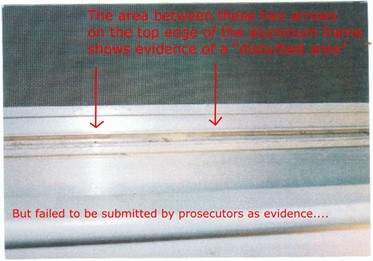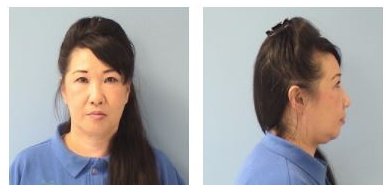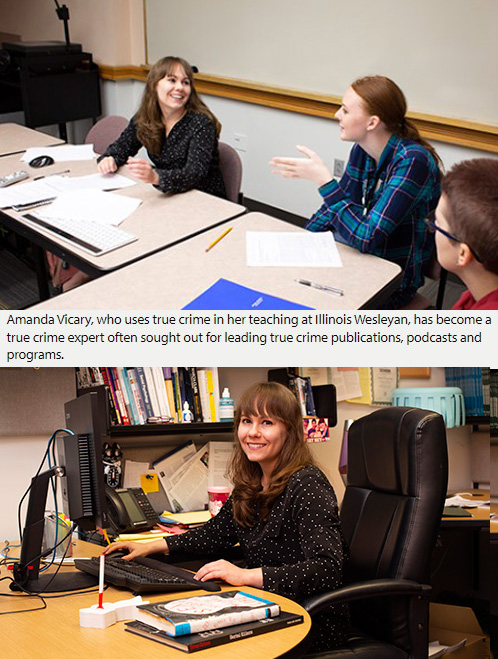2021 March 18 Comprehensive News Article – A Chance of Freedom for Wrongfully Convicted Man Serving 100 Years for the Death of His 3-Year-Old Daughter (Davis Vanguard Court Watch)

Published March 18, 2021
By Lovepreet Dhinsa, Linhchi Nguyen, and Kathryn Wood
BLOOMINGTON – After 23 years of serving in prison, Barton Monroe McNeil will finally have the chance to be acquitted in an upcoming retrial after being wrongfully convicted for murdering his three-year-old daughter.
On the morning of June 16, 1998, McNeil discovered his daughter, Christina, lying dead in his bedroom. Evidence surrounding the event led him to believe that Christina was murdered by his ex-girlfriend, Misook Nowlin.
However, despite his constant attempt to communicate to the Bloomington Police Department in order to bring justice to his daughter, prosecutors and police turned on him instead, while allowing for the true murderer, Nowlin, to escape and commit another murder of her own mother-in-law.
McNeil’s cousin, Chris Ross, was able to provide much of the information for this article, including McNeil’s post-conviction petition, court transcripts, and his own testimony of what occurred. Ross has been involved with this case since 2010, where he has since followed closely the evidence and progress of McNeil’s petition.
The Death of Christina McNeil
On June 15, 1998, Bart McNeil was taking care of his three-year-old daughter, Christina McNeil, over at his apartment. After a long day of taking her out to eat at McDonald’s and watching a Disney movie together, he put her to bed in his room around 10 p.m. and went to rest on the living room couch.
However, later in the night, he heard some voices through the bedroom door, causing him to return to the room and check on Christina. As he opened the door, he saw Christina, sitting upright in her bed with an open book and babbling to herself. There didn’t seem to be anyone else in the room.
According to Chris Ross, McNeil then told Christina to go to bed early, so she could attend daycare the next morning. He took her book, tucked her in, and left the room. This was the last time McNeil saw Christina alive.
Around 7 a.m. the next morning, McNeil opened the room to find his daughter, lying lifelessly on the bed. Her body was cold and stiff to the touch, with one eye partially open. In a frantic response, McNeil dialed 911 to call for help.
“I need an ambulance! I need it fast…My daughter is dying I think,” McNeil cried through the phone. According to the 911 call transcript, his voice was “quivering, in hysterics, and sobbing between words” as he tried to explain his situation to the police.
As the dispatcher tried to transfer the information to a rescue unit, McNeil was heard crying and yelling out “Christina” multiple times, his voice clearly mixed with grief through the audio.
A few moments later, the paramedics arrived, but unfortunately, Christina was pronounced dead at the hospital. Her death was initially thought of as a result of natural causes, perhaps related to her severe asthma attacks that she had the year prior.
However, as McNeil returned to the apartment and looked more closely at the details of his surroundings, he realized a different reason that may have caused his daughter’s death.
Inside his bedroom where she slept, there was a fallen window fan on the floor. There were also scuff marks and trampled plants outside below the window—things that McNeil knew were not there before.
Most importantly, he noticed two holes cut into the window screen right above the latches, which were unlatched. The holes were small and discreet, but big enough where someone could have stuck their fingers through. It occurred to McNeil that someone had intentionally removed the screen to gain access to his daughter’s room.
Coincidentally, 12 hours before Christina’s death, McNeil had had a dramatic fight with his ex-girlfriend, Misook Nowlin, at a public restaurant called Avanti’s.
During this event, Nowlin, who worked as a translator for a mobile phone company at that time, angrily presented McNeil with his own telephone transcripts which she illegally searched from her job. The transcripts revealed McNeil to be communicating with a woman in the Philippines, which caused Nowlin to lash out in jealousy.
This wasn’t the first time that Nowlin showed jealous and violent tendencies toward McNeil. Her tumultuous relationship with him started approximately three years prior when they met through a mutual friend at a Red Lobster, where McNeil worked. Despite already being married to Tita McNeil, the mother of his child, he decided to divorce her to go out with Nowlin.
They eventually moved in together, which is when signs of Nowlin’s aggression began to appear. “We had many fights,” McNeil explained to a police detective in one of his interrogations. “The police were over at our house on three, maybe four, separate occasions.”
According to Ross, even the neighbors would report to the police about observing “an Asian woman pounding on his door during late hours of the night.”
McNeil added that, “[Misook’s] motive is a maniacal desire to have me at any cost. And she has told me this many times, ‘I will kill myself if I cannot have you.’ I gave way to three or four different people…who have confirmed that they have heard her say this on numerous occasions, that she will kill herself, [or] she will kill somebody else.”
During one of their fights involving the police back in 1997, Nowlin was charged with assault after getting into a physical altercation with McNeil in front of Christina. McNeil expressed that he was fearful for his daughter’s safety. The Bloomington Police Department arrested Nowlin and, later, the court made her attend anger management classes.
Now, fast forward to the day of their fight at Avanti’s, and “this was a monumental day” for Bart because he finally said, ‘This isn’t going to work out between me and Misook. I need to break up with her formally, once and for all,’” stated Ross.
It also just so happened that Nowlin was one of the first people to show up at McNeil’s house immediately after the paramedics and police arrived around 8:15 in the morning. “To me, as a lay person,” said Ross. “This sounds like a type of person who wants to micromanage what’s going on and kind of control the investigation.”
Placing all these clues together, McNeil came to the conclusion that Christina was murdered by no other than Misook.
In an interview with Scott Reeder, a host for an NPR podcast, called “Suspect Convictions,” McNeil mentioned that before he ultimately identified Nowlin to be the culprit of Christina’s death, his ex-wife already faced some suspicions.
“The first person to suspect that Misook might have had anything to do with Christina’s death was not me. It was Christina’s mother, Tita, who saw Misook’s car parked in front of my apartment,” he said.
Indeed, Tita was also the one who noticed some strands of hair attached to Christina’s hands, which appeared to be longer than Christina’s own hair.
Once McNeil suspected Nowlin, he quickly called the police again on that same day at around 6 p.m., begging them to bring in a homicide detective.
“My name is Bart McNeil,” he told the first police officer in the call. “My daughter was found dead by me this morning at this address. The detectives were here, the coroner, everything. I need a detective here, the homicide detective please. I have reasons to believe now that she was murdered, and I need a detective here immediately. I don’t know if they saw this or not, but I just discovered this.”
McNeil made this call three more times to the Bloomington Police Department, urging them to send him a homicide detective right away. Finally, the department sent an investigation team to inspect the crime scene.
Some of the evidence recovered from the apartment include Christina’s stained bedding, pillow case, nightshirt, underwear, fingerprints on the window sill, hair collected from the pillowcase, some skin cells, and the window screen.
Most of the spots on the sheet were never tested for DNA profiles, neither was the pillowcase, Christina’s clothing, nor the fingerprints. However, the detectives did notice that when they were taking out the window from its wooden frame, the screen completely fell out, indicating that the screen may have been misplaced.
Bart McNeil’s Interrogations
A few days after McNeil had called the Bloomington Police Department, McNeil was called into the police station around 9 p.m.
The Bloomington Police Department is fairly inexperienced with murder cases, with only about one murder case every two years.
McNeil was not aware that he was now a suspect in his daughter’s murder, and multiple police officers took turns asking him a litany of questions. McNeil was asked the same questions by each police officer, until he asked them to “all show up at the same time” or to “turn on the camera,” so he didn’t have to constantly repeat himself.
Most of these interviews were transcribed by a detective, which can be prone to significant error, especially with the overwhelming amount of repetition. This was proven in the detective’s narration of the first interview with multiple officers, which was inherently different from that of the recording. Nowlin’s interview was also recorded and transcribed, both of which had large amounts of discrepancies.
Unfortunately, some of these transcriptions were later utilized by the prosecution when they presented evidence in court to convict McNeil.
In one of the interviews, McNeil was shown to be placed into an uncomfortable, ice-cold interrogation room, where he was only wearing shorts and a t-shirt. Unfortunately, the subsequent interview that followed, which lasted for over seven hours, was not taped, despite McNeil’s insistence that it should.
At that time, there were no laws requiring all interviews to be recorded, so the Bloomington Police Department did not feel obligated to do so.
McNeil explained to the police that he could get Nowlin to confess if he was placed into the same room with her. Although the police complied, this ended up not being an ideal situation for McNeil as he was engulfed with emotional rage after hearing about Christina’s autopsy report.
It was revealed that Christina had died from smothering, asphyxiation, and she was also sexually molested or assaulted (which was concluded from the traces of blood on her undergarments).
In an effort to make Nowlin confess, McNeil lashed out and accused her of committing these crimes.
After this situation, the department decided to continue interrogating McNeil, while Nowlin was able to go home and eliminate any incriminating evidence. Two days after this interview, the police department acquired a search warrant to collect sexual aids, which Nowlin had made certain to dispose of.
Within this interview, the Bloomington Police Department tortured and attempted to coerce McNeil to confess to a crime he did not commit.
Misook Nowlin’s Interrogations
Meanwhile, Nowlin’s interrogation differed significantly from McNeil’s, in several ways. While McNeil was hunched over in his chair speaking with officers to plead his case, Nowlin had the complete opposite experience.
Her legs and arms were crossed in the entire duration of the interrogation, demonstrating a calm demeanor. She also used hand gestures when explaining information and was comfortably swiveling in her chair.
When the detectives left the room for a nine-minute break, the tape recording captured Nowlin picking up an address book on the table for about one minute and reading it through it before she resumed her previous position.
It was also noted that while Nowlin was being questioned, the detective would answer the question for her in numerous instances throughout the interrogation. Therefore, before Nowlin was even able to provide a response, and possibly incriminate herself, the detective would either talk over her or prompt her to give a specific answer that would further incriminate McNeil or fill up the time with irrelevant questions.
As shown in the images below, the posture and questioning style of the detective was far more relaxed than the detective in McNeil’s interrogation.

Nowlin was also administered a polygraph test that summer, while McNeil was not. Nowlin had given inconsistent statements throughout that entire test, in which she failed the four key questions of “do you know when, do you know how, were you there, and did you do it?”
The notes of the lead detective in the case showed a “D” for deception on each of these four key questions. However, her exam results were masked as being inconsistent due to “language barrier issues,” despite the fact that she had lived in the United States since 1989 and worked as a Korean/English translator for a mobile phone company.
Bart McNeil’s Arrest and Trial
After McNeil’s seven-plus-hour interrogation on June 16, 1998, he was arrested and taken into custody for the murder of Christina, despite his repeated explanation that Christina was probably smothered by Nowlin.
The prosecution’s case was based significantly on proximity, in which there was no substantial evidence directly pointing to McNeil being involved in the murder of his own daughter. The prosecution additionally denied evidence that could point to Nowlin as the murderer.
Instead, their case was rooted in the spider webs and holes in the window screen. The prosecutor concluded that the spider webs on the window indicate that the windows were not tampered with, within 24 hours. This was proven false later on by multiple expert witnesses.
The prosecution also ignored the fact that the window screen in the daughter’s room had a gaping hole in it, which was large enough to poke fingers through. Instead of exploring this further, the prosecutor concluded that these holes could have been there before.
The entire trial lasted a 2.5 days, even though there were multiple witnesses, expert witnesses, and investigators.
Additionally, McNeil was not given a fair defense because of his defense attorney and detective, who were inexperienced in handling felony murder cases.
Detective Larry Shepherd, who was assigned to McNeil’s case, was the head of the Juvenile Crimes Unit, but had limited experience in investigating a murder case. Later, Shepherd was also involved in Nowlin’s second case, in which Nowlin was the lead suspect. This occurred within less than 90 days after this investigation, which only further exacerbated the conflict of interest in this case.
As for McNeil’s defense attorney, Tracy Smith had never been a lead attorney on a murder case. On top of that, Smith was responsible for exchanging McNeil’s entire case file with the prosecution for some documents that explained the felony battery charge against Nowlin, all of which was done without McNeil’s permission.
In stark contrast to the defense, the state called on 15 witnesses of their own to testify against McNeil. The defense attorney only called on three witnesses, and their entire direct testimony only took up about 62 pages, the majority of which was McNeil’s own testimony, compared to 262 pages from the prosecution.
According to McNeil, his own testimony would have been lengthy; however, the defense attorney did not intend to call McNeil until McNeil specifically insisted. Because of the unplanned testimony, the defense attorney never prepared nor discussed what it would entail for McNeil to take the stand.
Not only did the attorney compromise the privacy of McNeil, but a large amount of evidence was overlooked in the initial investigation.
For one, there was evidence of McNeil’s windows being broken into. This was presented by a reporter from the Pentagraph, named Steve Arney, who personally took photos of the window screen, showing that when the screen had been removed, an area appeared clean.

This evidence could have substantiated McNeil’s belief that the killer had entered Christina’s bedroom window, but it was never turned in by McNeil’s attorney.
Second, McNeil was precluded from presenting any evidence pertaining to Nowlin’s involvement in this offense, including her past charge for assault in front of McNeil and Christina.
“My trial was a lightning quick 2.5 days. I was muzzled because I could not speak of Misook murdering my child,” McNeil once said in a statement.
And due to an agreement, unbeknownst to McNeil, between the attorneys and Tita to allow Christina to be cremated, McNeil was unable to get a defense pathologist to collect the evidence from Christina’s body. They were only able to rely on the autopsy provided by the prosecution, which later turned out to be flawed.
Finally, a crucial piece of evidence, which was a videotape recording of significant findings in McNeil’s apartment, was missing in his case.
This videotape included various shots of the crime scene, including the two distinct holes on either side of the window screen and scuff marks under the bedroom window. This video would have shown proof of purposeful tampering of McNeil’s apartment and plants in the front yard.
Even though McNeil insisted to his attorney, Tracy Smith, to review this evidence, he was never able to obtain it. Records showed that this tape went from the coroner’s office to the Bloomington Police Department, even though the attorney’s only response was that “it wasn’t in their possession.”
Misook Nowlin’s Murder of Her Mother-in-Law
After McNeil’s trial, Nowlin went on to commit more violent crimes, which include causing great bodily injury to a child through suffocation and murdering her mother-in-law, which ultimately exposed her culpability over Christina’s death.
First, evidence of Nowlin being a threat to her own daughter, Michelle, surfaced when the daughter’s school principal testified in court in March 1999. The principal revealed that Nowlin had pinched her daughter’s nose shut, covered her mouth, and beat her with a wooden dowel in the pelvic region, which caused significant bruising. Nowlin also threatened to kill her daughter, “just like [how] Christina died.”
Michelle’s stepmother also attested to this abuse, stating that Michelle told her about Nowlin hitting her and threatening, “I’m going to kill you. You’re going to die tonight.”
Unfortunately, Michelle even went to school with bruises along her hip, thighs, and buttocks. She admitted to her principal that “her mother had put her hand over her mouth, and she couldn’t breathe.”
Following these series of events, the principal turned Nowlin into the Department of Children and Family Services, where an investigator confirmed that Nowlin was an “unfit parent.”
On June 18, 1999, the court found Nowlin guilty of domestic battery on nine-year-old Michelle, after attempting to suffocate her on multiple accounts. Nowlin later wrote a letter to Michelle, explaining how her motivations for her violent acts were due to her husband’s affair which “drove me crazy,” and she wrote that her “heart just couldn’t stand the loneliness.”

(A mugshot of Misook Nowlin provided by the Illinois Department of Correction photos is provided.)
Then, on Sept. 4, 2011, Linda Tyda, Nowlin’s mother-in-law, was murdered. Nowlin pleaded guilty in court, stating that she attempted to cover up the homicidal death by “burying Tyda’s body in a shallow grave in a forest preserve.”
During the trial, the evidence displayed Nowlin luring Tyda to the crime scene after having someone pretend to give Tyda $500 to drive them to the airport.
Nowlin also tried to declare that she killed Tyda as an act of self-defense, but the court convicted Nowlin of first-degree murder.
In McNeil’s petition for a retrial, his attorneys pointed out the striking similarities between the deaths of Christina and Tyda. In both cases, Nowlin was infuriated after her romantic relationships ended, especially when she suspected that they had cheated on her. On both accounts, she even searched their phone records to scope out if there was evidence of their cheating.
The weeks before both murders, Nowlin was seen banging on her partner’s doors late at night. In both instances, Nowlin blamed the victims for the fallout of her romantic relationships and intended on ruining her ex-partner’s lives.
Nowlin told her sister on a recorded jailhouse phone call regarding her partner: “I’ll get every single thing from him, I’ll completely ruin him, completely.”
Furthermore, in both cases, Nowlin threatened or actually took her partner’s child away. With McNeil, she allegedly killed his child, and with her husband, she threatened him that, if they got a divorce, she would take their son to California.
Additionally, both victims were the closest female relative to the ex; Christina was the daughter of McNeil, while Tyda was the mother of Nowlin’s husband.
In both murders, the evidence presented in court displayed that the victims were strangled.
In Christina’s case it was originally claimed she was killed by asphyxiation, while in Tyda’s case, Nowlin wrote a letter to Michelle detailing, “I started to lose control of myself too and pushed Linda away. After that we came into a situation where we were strangling each other. I was really out of my mind. Oh my God. What have I done? When I came to myself again the whole world had changed into a different one. I had become a murderer, and the dead body of Linda before my eyes was turning me into a devil.”
Lastly, in both cases, after the police questioned Nowlin, she shifted the blame away from her framing.
In Michelle Nowlin’s affidavits, she noted that McNeil “never treated [her] badly…never did anything inappropriate to [her],” and she “never saw Barton do anything inappropriate to Christina McNeil.”
At Linda Tyda’s funeral, Michelle mentioned that Don Wang, her stepfather, told her that Nowlin “once told him that she had killed Christina McNeil in 1998.”
Additionally, Dawn Nowlin, Michelle’s stepmother, attests to this, claiming that at the funeral, Don Wang also stated to her that, when he was in a fight with Misook, “Misook admitted to killing Christina McNeil.”
Out of the three friends that testified on Nowlin’s behalf, none of them were able to give an alibi for the time frame associated with the death of Christina.
The Post-Conviction Petitioning Process – Hopefully a Happy Ending for Bart McNeil
McNeil has endured a long petitioning process over the course of being incarcerated. After being sentenced to 100 years in prison, McNeil’s pro se motion in 2002 to reconsider his sentence and take into account other important evidence was denied.
This sentence was affirmed on appeal and McNeil’s petition for leave to appeal to the Illinois Supreme Court was struck down.
In 2003, McNeil ’s pro se motion for post-conviction DNA testing was denied.
In 2005, McNeil’s pro se post-conviction petition for ineffective assistance of counsel, as well as his jury waiver not being voluntary, failed.
In 2013, McNeil filed a post-conviction request for DNA testing and DNA analysis from objects in Christina’s bedroom, as well as her clothing.
In 2014, the Court agreed and tested “the stains on Christina’s underwear,” “the stains on Christina’s t-shirt,” a latent fingerprint “found on the inside of the bedroom window in Christina’s room,” the screen of the window, “the bedsheet,” and “the pillowcase.”
Finally on Feb. 23, 2021, after a prolonged period of paperwork and collecting evidence, lawyers from the University of Chicago Law School’s Exoneration Project and the Illinois Innocence Project successfully filed a 65-page petition and four volumes of exhibits for McNeil, who is now able to have a retrial to defend his innocence.
The group of attorneys representing McNeil plan to challenge key evidence used by the state to convict McNeil during his four-day bench trial.
New Evidence That Has Been Discovered
Within McNeil’s petition for post-conviction relief, newly-discovered evidence is revealed to prove McNeil’s innocence and acquit him of his charges.
The two issues that are included in the appeal refer to one, how the trial court erred in excluding the evidence proving that Nowlin had both the motive and opportunity to kill Christina. And, two, they argued that McNeil’s life sentence should be eliminated because the statute that he was sentenced under was unconstitutional.
The petition indicated that, after a series of post-conviction DNA testing, Nowlin was found to be heavily correlated with the scene of Christina’s death.
Three hairs were retrieved from the scene from Christina’s arms, hands, and bed. Although two of the hairs were claimed to be unsuitable for testing, the third hair, which was found inside Christina’s pillowcase, was linked to Nowlin’s DNA.
After the bedsheet was tested, DNA from Christina, McNeil, and Nowlin appeared. The DNA analysis displayed Nowlin’s DNA on six areas of the sheet.
The TrueAllele probabilistic genotyping software determined the ratio of the DNA mixtures from Nowlin, Christina, and McNeil and found that it is 7.81 quadrillion times more likely that the DNA on the sheet was from Nowlin compared to any other person.
Furthermore, DNA on the pillowcase appeared 7.39 million times more likely that the DNA was Nowlin’s DNA compared to anyone else.
Therefore, Nowlin’s DNA was present at the scene of Christina’s crime on multiple places on Christina’s bed sheet. With this newly-discovered evidence, it proves that Nowlin was much more likely to be the suspect for Christina’s murder, not McNeil.
Reinterpretation of Autopsy Reports
The initial autopsy of Christina’s body was conducted by pathologist Violet Hnilica. She reported that Christina had contusions on her mouth, forehead, chin, left thumb, and mid-back. Additionally, Hnilica indicated that she had petechiae, small round spot on the skin representing ruptured capillaries in her lungs and thymus, as well as blood spots on her clothing and bed sheets.
Hnilica concluded that the three-year old was smothered, with evidence of sexual trauma concluded to have been caused by McNeil.
However, according to the petition, modern medical science refutes these claims and identifies them to be “baseless.”
Dr. Andrew Baker, a forensic pathologist and Chief Medical examiner for Hennepin, Dakota, and Scott counties in Minnesota, has a wide range of experience in this field and specializes in child abuse and child deaths.
Dr. Baker stated that Hnilica’s autopsy examination was heavily flawed, reporting that “nothing about the autopsy findings in Christina McNeil’s case supports an objective, independent, diagnosis that she was smothered or that the manner of death was a homicide.”
Dr. Baker focused on how the initial findings from the autopsy conducted by Hnilica from the standard of modern science today displays that they were “baseless and unsubstantiated.”
To begin, Dr. Baker explained that the petechiae observed in the initial autopsy “offer no evidence that Christina was smothered.”
Dr. Baker disproved Hnilica’s discussion of bruises, indicating that there were no injuries on her back during the initial examination, and the noted injuries were observed after the funeral director handled her body, which was in the beginning process of decomposing, and the results were postmortem consequences.
Furthermore, the facial injuries that Hnilica mentioned by Dr. Baker’s account were “non-specific, and microscopically were not confirmed as actual injuries.”
The “reliance on these injuries to support a diagnosis of smothering was completely unfounded,” he affirmed.
Dr. Baker also added that “[l]ike the biopsies of the back, these facial findings appear to have been biopsied after Christina’s body had been prepared by a funeral director.
In terms of the cause of death, Dr. Baker found that based on modern science standards, he “would have certified the cause of death as sudden unexplained death in childhood (SUDC) and the manner of death as undetermined.”
Hnilica’s initial autopsy also pointed to the claim that Christina’s stomach contents suggest that she died two hours after her last meal.
However, Dr. Baker acknowledged that stomach contents cannot be used as a reliable measure for the time of death and includes that “meals of higher caloric and osmotic content are known to empty from the stomach more slowly,” making it a hard rule of thumb and “liable to mislead the investigator and the court.”
Furthermore, based on modern science, Hnilica’s conclusion about Christina enduring sexual molestation and abuse was “scientifically inaccurate and utterly baseless.”
Dr. Nancy Harper, the Director of the Otto Bremer Trust Center for Safe and Healthy Children in the Division of Pediatric Emergency Medicine and Child Abuse at the University of Minnesota Masonic Children’s Hospital and Associate Professor of Pediatrics at the University of Minnesota, specializes in child abuse and sexual molestation.
She stated that “there are no findings considered indicative of acute anogenital trauma or the residua of prior anogenital trauma.”
Instead, Dr. Harper claimed that “the examination as documented in the forensic pathology report and in the photos is a normal anogenital examination in a prepubertal female.”
Furthermore, she asserted that “the hymenal appearance is considered a normal variant.
“At the time of the postmortem examination” of Christina, “there was debate in the literature on the significance of the transverse or horizontal measurement of the hymen,” however, “the current scientific literature does not support an association between the transverse diameter of the hymenal opening and child sexual abuse,” Dr. Harper stated.
The hyperemia and redness that was examined in the initial autopsy as reported by Dr. Harper is “a common finding in girls with or without a history of sexual abuse.”
Additionally, the anal dilatation in the initial findings “should be considered an expected finding that is not the result of trauma or sexual contact.”
Therefore, modern science standards reject the initial autopsy results conducted by Hnilica involving Christina’s alleged sexual abuse.
Reinterpretation of Spider Web Evidence
Despite what the prosecution held on the significance of the spider webs outside of Christina’s window, spider web experts refute these claims.
Ross reached out to Fitz Volratz, a spider web expert, and shared pictures that the police captured of the spider webs outside of Christina’s window.
Following the initial police visit, the police came back to McNeil’s house the second time and took pictures of the cut window screen 8-10 hours later.
Volratz mentioned that “a spider coming out of hiding and spinning a web and repairing its web” was completely likely.
Volratz referred Ross to Dr. Jonathon Coddington, a lead entomologist and Director for Science at the Smithsonian National Museum of Natural History, and Dr. Todd Blackledge at the University of Akron.
Shortly after, the Illinois Innocence Project was contacted.
An important note made by the experts indicated that when a spider web gets broken, the spiders will come out of hiding and repair their web. According to Ross, Dr. Blackledge testified in 2014 that there could have been an “intruder that entered through this window” and “the presence of spider webs” when the police arrived the second time does not prove anything.
Furthermore, relying on the Bloomington Police Department to report what they observed that evening and drawing conclusions based on this evidence is insufficient.
Instead, spider web experts should have been initially involved on behalf of McNeil’s defense in order to refute the police department’s flawed claims and prove that there could have been an intruder, regardless of the fact that there were spider webs on the window.
How is Bart McNeil’s Case Reflective of the US Criminal Justice System?
During an interview that The Vanguard conducted with Ross, he was asked about how he thought McNeil’s case was reflective of the US criminal justice system. Ross responded that McNeil’s case is a great example of “how the system is broken” and “needs to be changed.
“He didn’t get a fair trial, [and in] Bart’s instance there was a lot of exculpatory information that was not handed over to the defense” he stated.
“When police and prosecutors work together, they really want to try and find as quick as possible the individual that they think can be likely to convict successfully [because] their constituents want to sleep well at night [and] know that the person who is perpetrating crimes or murdered someone…is off the streets” Ross added.
Ross claimed that “their investigation is only going to go so wide and so deep until they have the person that they feel fits and has a motive.”
McNeil was convicted “on circumstantial evidence alone, [and] there is nothing that ties him to Christina…there’s nothing that connects him to her death…yet they were able to convict him on circumstantial evidence.” Ross mentioned.
In applying McNeil’s case to the bigger picture, he added that “now we have the giant privatization of prisons [and] 2.3 million incarcerated people in America. Of that incarceration number…we have 25 percent of the entire world’s prison population, [and] many of these prisons now are being run for profit.”
He also suggested that “there needs to be accountability with prosecutors, state’s attorneys, and detectives. Bart is not alone…with 2.3 million people, you are going to make mistakes…you are going to make a lot of mistakes.
“There are loved ones that are living out their lives…maybe decades at a time or lifetime imprisonment who die in prison who were not guilty, and they were able to be successfully prosecuted and convicted,” Ross stated.
“What a travesty…it’s impossible for anyone to ever walk in Bart’s shoes.”
Conclusion
Bart McNeil will be represented by attorneys from the Illinois Innocence Project and University of Chicago Law School’s Exoneration Project in his upcoming trial on Wednesday, April 14, at 1:30 p.m. at the McLean County Courthouse.
The presiding judge will be Judge William A. Yoder, who, interestingly, was the McLean County State’s Attorney during McNeil’s re-sentencing hearing in 2002 and when Nowlin was charged for first-degree murder in September 2011. No doubt, he will have some familiarity in hearing about McNeil’s case.

To sign up for our new newsletter – Everyday Injustice – https://tinyurl.com/yyultcf9







